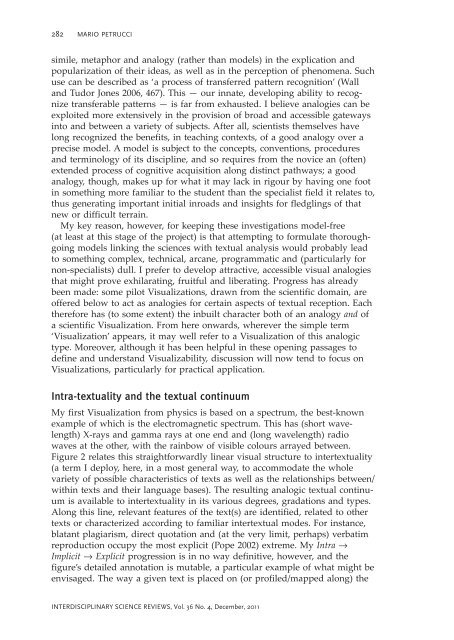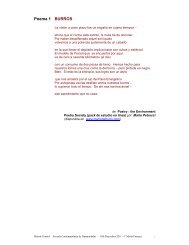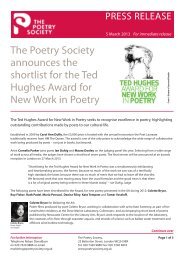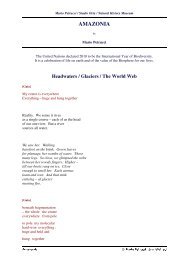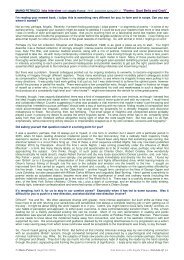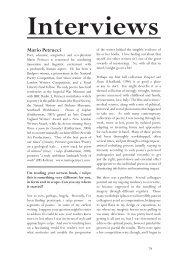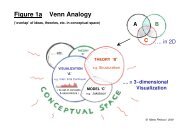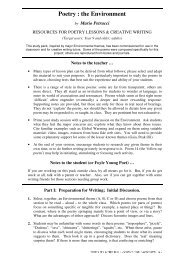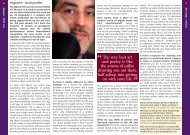Scientific Visualizations: Bridge-Building between ... - Mario Petrucci
Scientific Visualizations: Bridge-Building between ... - Mario Petrucci
Scientific Visualizations: Bridge-Building between ... - Mario Petrucci
Create successful ePaper yourself
Turn your PDF publications into a flip-book with our unique Google optimized e-Paper software.
282 MARIO PETRUCCI<br />
simile, metaphor and analogy (rather than models) in the explication and<br />
popularization of their ideas, as well as in the perception of phenomena. Such<br />
use can be described as ‘a process of transferred pattern recognition’ (Wall<br />
and Tudor Jones 2006, 467). This — our innate, developing ability to recognize<br />
transferable patterns — is far from exhausted. I believe analogies can be<br />
exploited more extensively in the provision of broad and accessible gateways<br />
into and <strong>between</strong> a variety of subjects. After all, scientists themselves have<br />
long recognized the benefits, in teaching contexts, of a good analogy over a<br />
precise model. A model is subject to the concepts, conventions, procedures<br />
and terminology of its discipline, and so requires from the novice an (often)<br />
extended process of cognitive acquisition along distinct pathways; a good<br />
analogy, though, makes up for what it may lack in rigour by having one foot<br />
in something more familiar to the student than the specialist field it relates to,<br />
thus generating important initial inroads and insights for fledglings of that<br />
new or difficult terrain.<br />
My key reason, however, for keeping these investigations model-free<br />
(at least at this stage of the project) is that attempting to formulate thoroughgoing<br />
models linking the sciences with textual analysis would probably lead<br />
to something complex, technical, arcane, programmatic and (particularly for<br />
non-specialists) dull. I prefer to develop attractive, accessible visual analogies<br />
that might prove exhilarating, fruitful and liberating. Progress has already<br />
been made: some pilot <strong>Visualizations</strong>, drawn from the scientific domain, are<br />
offered below to act as analogies for certain aspects of textual reception. Each<br />
therefore has (to some extent) the inbuilt character both of an analogy and of<br />
a scientific Visualization. From here onwards, wherever the simple term<br />
‘Visualization’ appears, it may well refer to a Visualization of this analogic<br />
type. Moreover, although it has been helpful in these opening passages to<br />
define and understand Visualizability, discussion will now tend to focus on<br />
<strong>Visualizations</strong>, particularly for practical application.<br />
Intra-textuality and the textual continuum<br />
My first Visualization from physics is based on a spectrum, the best-known<br />
example of which is the electromagnetic spectrum. This has (short wavelength)<br />
X-rays and gamma rays at one end and (long wavelength) radio<br />
waves at the other, with the rainbow of visible colours arrayed <strong>between</strong>.<br />
Figure 2 relates this straightforwardly linear visual structure to intertextuality<br />
(a term I deploy, here, in a most general way, to accommodate the whole<br />
variety of possible characteristics of texts as well as the relationships <strong>between</strong>/<br />
within texts and their language bases). The resulting analogic textual continuum<br />
is available to intertextuality in its various degrees, gradations and types.<br />
Along this line, relevant features of the text(s) are identified, related to other<br />
texts or characterized according to familiar intertextual modes. For instance,<br />
blatant plagiarism, direct quotation and (at the very limit, perhaps) verbatim<br />
reproduction occupy the most explicit (Pope 2002) extreme. My Intra →<br />
Implicit → Explicit progression is in no way definitive, however, and the<br />
figure’s detailed annotation is mutable, a particular example of what might be<br />
envisaged. The way a given text is placed on (or profiled/mapped along) the<br />
INTERDISCIPLINARY SCIENCE REVIEWS, Vol. 36 No. 4, December, 2011


